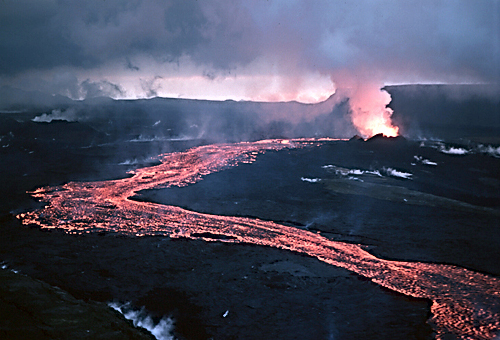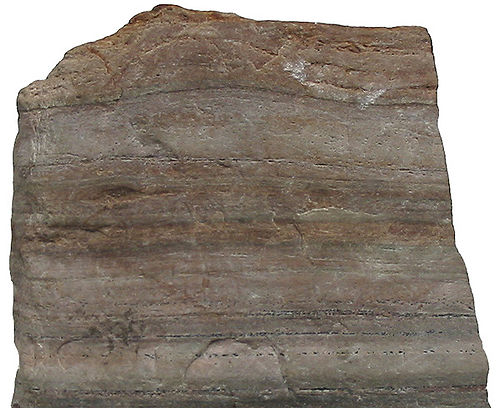High School Earth Science/Types of Rocks
Have you ever heard something described as "rock solid"? We usually use the phrase to describe something that does not and cannot change. It also means something is absolutely sure and will not fail or go wrong somehow. If we say a plan is rock solid that means the plan is a sure bet—it will not change and it will not go wrong. When you see pictures like this rocky mountainside in Costa Rica, it is easy to get the feeling that rocks neither change nor move, but instead always stay the same (Figure 4.1).

Lesson Objectives
[edit | edit source]- Define rock and describe what rocks are made of.
- Know how rocks are classified and described.
- Explain how each of the three main rock types are formed.
- Describe the rock cycle.
The Rock Cycle
[edit | edit source]

The truth is, however, that rocks do change. All rocks on Earth change as a result of natural processes that take place all the time. These changes usually happen very slowly. They may even happen below Earth's surface so that we do not notice the changes. The physical and chemical properties of rocks are constantly changing in a natural, never-ending cycle called the rock cycle. The rock cycle describes how each of the main types of rocks is formed, and explains how rocks change within the cycle. This lesson will discuss the characteristics of rocks, how rocks are classified, and details of the rock cycle. The following three lessons of this chapter will discuss the three main types of rocks in more detail.
A rock is a naturally-formed, nonliving Earth material. Rocks are made of collections of mineral grains that are held together in a firm, solid mass (Figure 4.2). The individual mineral grains that make up a rock may be so tiny that you can only see them with a microscope, or they may be as big as your fingernail. A rock may be made of grains of all one mineral type, or it may be made of a mixture of different minerals. Most rocks contain more than one mineral. Each rock has a unique set of minerals that make it up, and rocks are usually identified by the minerals observed in them. Since different minerals form under different environmental conditions, the minerals in a rock contain clues about the conditions, like temperature, that were present when the rock formed.
Rocks can also be described by their texture, which is a description of the size, shape, and arrangement of mineral grains. Rocks may be small pebbles less than a centimeter, or they may be massive boulders that are meters wide (Figure 4.3). Smaller rocks form when larger rocks are broken apart and worn down.
Three Main Categories of Rocks
[edit | edit source]Rocks are classified according to how they were formed. The three main kinds of rocks are:
1. Igneous Rocks - form when magma (molten rock inside the Earth) or lava (molten rock that has erupted onto the surface of Earth) cools either at or below Earth's surface (Figure 4.4).

2. Sedimentary Rocks - form by the compaction of sediments, like gravel, sand, silt or clay (Figure 4.5). Sediments may include fragments of other rocks that have been worn down into small pieces, materials made by a living organism or organic materials, or chemical precipitates, which are the solid materials left behind after a liquid evaporates. For example, if a glass of salt water is left in the sun, the water will eventually evaporate, but salt crystals will remain behind as precipitates in the bottom of the glass.

3. Metamorphic Rocks - form when an existing rock (of any type) is changed by heat or pressure within the Earth, so that the minerals undergo some kind of change (Figure 4.6).

Rocks can be changed from one type to another, and the rock cycle describes how this happens. Figure 4.7 shows the rock cycle, and how the three main rock types are related to each other. The arrows within the circle show how one type of rock may change to rock of another type. For example, igneous rock may break down into small pieces of sediment and become sedimentary rock, or it may be buried within the Earth and become metamorphic rock, or it may change back to molten material and re-cool into a new igneous rock.

Processes of the Rock Cycle
[edit | edit source]Any type of rock can undergo changes and become any new type of rock. Several processes are involved in the rock cycle that make this possible. The key processes of the rock cycle are crystallization, erosion and sedimentation, and metamorphism. Let's take a closer look at each of these:
Crystallization. Crystallization occurs when molten material hardens into a rock. An existing rock may be buried deep within the earth, melt into magma and then crystallize into an igneous rock. The rock may then be brought to Earth's surface by natural movements of the Earth. Crystallization can occur either underground when magma cools, or on the earth's surface when lava hardens.
Erosion and Sedimentation. Pieces of rock at Earth's surface are constantly worn down into smaller and smaller pieces. The impacts of running water, gravity, ice, plants, and animals all act to wear down rocks over time. The small fragments of rock produced are called sediments. Running water and wind transport these sediments from one place to another. They are eventually deposited, or dropped somewhere. This process is called erosion and sedimentation. The accumulated sediment may become compacted and cemented together into a sedimentary rock. This whole process of eroding rocks, transporting and depositing them, and then forming a sedimentary rock can take hundreds or thousands of years.
Metamorphism. Sometimes an existing rock is exposed to extreme heat and pressure deep within the Earth. Metamorphism happens if the rock does not completely melt but still changes as a result of the extreme heat and pressure. A metamorphic rock may have a new mineral composition and/or texture.

Note that the rock cycle really has no beginning and no end: Therefore, it's a never-ending cycle. The concept of the rock cycle was first developed by James Hutton, an eighteenth century scientist often called the "father of geology" (Figure 4.8). Hutton spoke of the cyclic nature of rock formation and other geologic processes and said that they have "no [sign] of a beginning, and no prospect of an end". The processes involved in the rock cycle take place over hundreds or even thousands of years, and so in our lifetime, rocks appear to be fairly "rock solid" and unchanging. However, a study of the rock cycle shows us that change is always taking place. The next three lessons of this chapter will discuss each type of rock in more detail.
Lesson Summary
[edit | edit source]- There are three main types of rocks; igneous, sedimentary, and metamorphic.
- Crystallization, erosion and sedimentation, and metamorphism transform one type of rock into another type of rock or change sediments into rock.
- The rock cycle describes the transformations of one type of rock to another.
Review Questions
[edit | edit source]- What is the difference between a rock and a mineral?
- Why can the minerals in a rock be a clue about how the rock formed?
- What is the difference between magma and lava?
- What are the three main types of rocks and how does each form?
- How can an igneous rock change to a metamorphic rock?
- How do sediments form?
- In which rock type do you think fossils, which are the remains of past living organisms, are most often found?
- Suppose that the interior of the Earth was no longer hot, but all other processes on Earth continued unchanged. How would this affect the distribution of rocks formed on Earth?
Vocabulary
[edit | edit source]- chemical composition
- Description of the elements or compounds that make up a substance and how those elements are arranged in the substance.
- deposited
- Put down or dropped by water or wind onto the ground.
- lava
- Molten rock at the surface of the Earth.
- magma
- Molten rock below Earth's surface.
- mineral
- Naturally-occurring solid that has a definite crystal structure.
- molten
- Something that is melted.
- organic
- Having to do with living things.
- precipitates
- Solid substance that separates out of a liquid; a solid substance that was once dissolved in a liquid and gets left behind when the liquid evaporates.
- sediments
- Small particles of soil or rock deposited by wind or water.
Points to Consider
[edit | edit source]- What processes on Earth are involved in forming rocks?
- Stone tools were important to early humans. Do you think rocks are still important to modern humans today?
